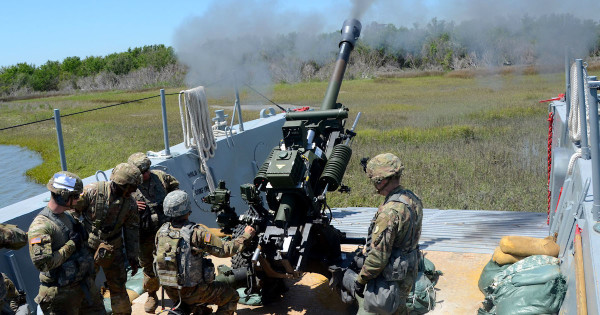

A Virginia Army National Guard unit travelled to the Marine Corps’ Camp Lejeune in North Carolina in late April for a relatively unusual training exercise: firing a howitzer from a landing craft in the Army’s first waterborne artillery mission since the Vietnam War and this particular unit’s first waterborne artillery mission since the D-Day landings nearly 75 years ago.
National Guardsmen from the 1st Battalion, 111th Field Artillery Regiment, 116th Infantry Brigade Combat Team conducted live fire exercises with 105mm M119A3 howitzer along the Intracoastal Waterway that runs from Lejeune along the Atlantic Ocean, according to Virginia Army National Guard public affairs.
The 1-111th soldiers was supported by mechanized Army landing craft, or “Mike boats,” were operated by active-duty soldiers from the 11th Transportation Battalion, 7th Transportation Brigade at Joint Expeditionary Base Little Creek—Fort Story, a combination that “effectively provides a mobile fire support system for amphibious operations and during missions in riverine and other littoral environments,” per The War Zone.

Virginia National Guard Soldiers assigned to the Norfolk-based 1st Battalion, 111th Field Artillery Regiment, 116th Infantry Brigade Combat Team conduct waterborne artillery live fire exercises during Operation GATOR April 24-25, 2019, at Camp Lejeune, North Carolina(U.S. National Guard/Mike Vrabel)
During the D-Day invasion of Normandy on June 6th, 1944, the 1-111th — known at the time as the 111th Field Artillery Battalion — landed at Omaha Beach alongside their fellow soldiers from the National Guard’s 29th Infantry Division. As The War Zone notes, today’s 111th fields both 105mm M119 and 155mm M777 howitzers, both equipped with modern targeting and fire control systems.
“With today’s weapons, the gun will actually track its location and know its direction at all times,” 1-111th commander said in a statement. “The gun had no issues initializing, finding its location, understanding where true north is. We went underway along the Intracoastal Waterway and the gun continued to track its GPS location and direction, which is a huge win.”
Waterborne artillery missions became a staple of riverine combat operations during the Vietnam War, Talmadge explained. “In Vietnam, this was a doctrine that was not only developed, but actually utilized and employed,” he said in a statement. “Today is a proof of concept to say hey, we can still do this.”

Virginia National Guard Soldiers assigned to the Norfolk-based 1st Battalion, 111th Field Artillery Regiment, 116th Infantry Brigade Combat Team conduct waterborne artillery live fire exercises during Operation GATOR April 24-25, 2019, at Camp Lejeune, North Carolina(U.S. National Guard/Mike Vrabel)
Or not: As Stars and Stripes points out, the Army is currently debating the deactivation of its National Guard and Reserve watercraft components, with Army Secretary Mark Esper stated in June 2018 that the Reserve would “divest all watercraft systems” following a thorough assessment of its fleet inventory.